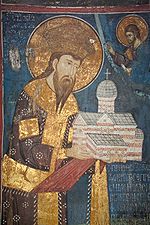Ktetor
Appearance
It has been suggested that this article be merged with Donor portrait. (Discuss) Proposed since April 2016. |

ktetor (Template:Lang-el) or ktitor (Cyrillic: ктитор; Georgian: ქტიტორი; Template:Lang-ro), meaning "founder", was a title given in the Middle Ages to the provider of funds for construction or reconstruction of an Orthodox church or monastery, for the addition of icons, frescos, and other works of art. It was used in the Byzantine sphere. A Catholic equivalent of the term is a donator. As part of founding the ktetor often issued typika, and was illustrated on frescoes ("ktetor portrait"). The female form is ktetorissa (Template:Lang-el) or ktitoritsa (Cyrillic: ктиторица).
References
- John Philip Thomas (1987). Private Religious Foundations in the Byzantine Empire. Dumbarton Oaks. pp. 254–. ISBN 978-0-88402-164-3.
- Geoffrey Wainwright (2006). The Oxford History of Christian Worship. Oxford University Press, USA. pp. 287–. ISBN 978-0-19-513886-3.
Wikimedia Commons has media related to Ktitor.
